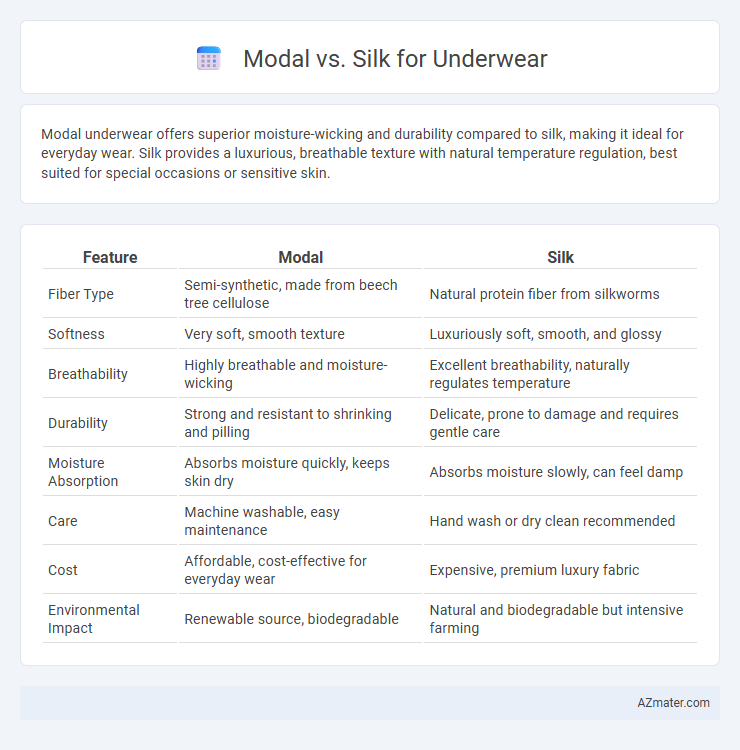Modal underwear offers superior moisture-wicking and durability compared to silk, making it ideal for everyday wear. Silk provides a luxurious, breathable texture with natural temperature regulation, best suited for special occasions or sensitive skin.
Table of Comparison
| Feature | Modal | Silk |
|---|---|---|
| Fiber Type | Semi-synthetic, made from beech tree cellulose | Natural protein fiber from silkworms |
| Softness | Very soft, smooth texture | Luxuriously soft, smooth, and glossy |
| Breathability | Highly breathable and moisture-wicking | Excellent breathability, naturally regulates temperature |
| Durability | Strong and resistant to shrinking and pilling | Delicate, prone to damage and requires gentle care |
| Moisture Absorption | Absorbs moisture quickly, keeps skin dry | Absorbs moisture slowly, can feel damp |
| Care | Machine washable, easy maintenance | Hand wash or dry clean recommended |
| Cost | Affordable, cost-effective for everyday wear | Expensive, premium luxury fabric |
| Environmental Impact | Renewable source, biodegradable | Natural and biodegradable but intensive farming |
Introduction to Modal and Silk Fabrics
Modal fabric, derived from beech tree pulp, is renowned for its exceptional softness, breathability, and moisture-wicking properties, making it an ideal choice for comfortable underwear. Silk, a natural protein fiber produced by silkworms, offers a smooth, luxurious texture with excellent temperature regulation and hypoallergenic qualities. Both fabrics provide breathable comfort, but Modal is prized for durability and stretch, while Silk excels in elegance and natural sheen.
Understanding Modal: Origins and Properties
Modal fabric, derived from beech tree cellulose, offers exceptional breathability and a smooth, silky texture ideal for underwear. Its moisture-wicking properties and resistance to shrinkage make it more durable and comfortable than traditional cotton. Modal's eco-friendly production process and natural dye absorption enhance its appeal for sustainable, high-quality lingerie.
The Luxurious Appeal of Silk Underwear
Silk underwear offers an unparalleled luxurious appeal with its smooth, lustrous texture and natural sheen that enhances comfort and elegance. The breathable and hypoallergenic properties of silk make it an ideal choice for sensitive skin while providing moisture-wicking benefits. Unlike modal, silk exudes sophistication and opulence, making it a preferred fabric for premium lingerie and high-end sleepwear.
Comfort Comparison: Modal vs Silk
Modal underwear offers exceptional breathability and moisture-wicking properties, making it ideal for all-day comfort and keeping skin dry. Silk underwear provides a smooth, luxurious feel with natural temperature regulation, ensuring softness against the skin but may lack moisture absorption compared to modal. Both fabrics deliver comfort, with modal excelling in durability and moisture management while silk offers unmatched softness and elegance.
Breathability and Moisture-Wicking Abilities
Modal underwear offers superior breathability and moisture-wicking properties due to its semi-synthetic cellulose fiber structure, which efficiently absorbs and releases moisture, keeping skin dry and cool. Silk, while naturally breathable and smooth, has limited moisture-wicking capacity, often retaining moisture longer and potentially feeling damp during intense activities. For optimal comfort in hot or humid conditions, modal's enhanced airflow and rapid moisture evaporation make it a preferred choice over silk.
Durability and Care Requirements
Modal underwear offers superior durability due to its strong cellulose fiber composition, maintaining shape and softness after multiple washes. Silk underwear, while luxurious and smooth, requires delicate handling and hand washing to prevent fabric damage and maintain its integrity. Modal's resistance to shrinkage and pilling makes it easier to care for compared to the high-maintenance nature of silk garments.
Sustainability and Environmental Impact
Modal, derived from sustainably sourced beech tree pulp, offers a biodegradable and eco-friendly alternative to traditional fabrics with lower water consumption and chemical use during production compared to conventional cotton. Silk production, while natural and biodegradable, often involves energy-intensive sericulture and raises ethical concerns about silkworm harvesting, impacting its sustainability profile. Choosing modal underwear supports eco-conscious consumers seeking reduced environmental impact through renewable resources and less resource-intensive manufacturing processes.
Hypoallergenic Qualities and Skin Sensitivity
Modal fabric exhibits excellent hypoallergenic qualities due to its natural origin from beech tree pulp, resulting in smooth fibers that are less likely to irritate sensitive skin. Silk, renowned for its natural protein structure, offers hypoallergenic benefits by repelling dust mites and reducing allergens, making it suitable for individuals with skin sensitivities or allergies. Both materials provide breathable, soft textures that minimize irritation and enhance comfort for those prone to skin reactions.
Price Differences: Modal vs Silk Underwear
Modal underwear generally offers a more affordable price point compared to silk underwear, making it accessible for everyday use without sacrificing comfort or durability. Silk underwear tends to be priced higher due to the luxurious fabric, natural fibers, and labor-intensive production process involved. Consumers seeking budget-friendly options often choose modal for its softness and moisture-wicking properties, while silk remains a premium choice valued for its smooth texture and elegant appearance.
Choosing the Best Fabric for Your Needs
Modal underwear offers exceptional softness, breathability, and moisture-wicking qualities, making it ideal for active lifestyles and all-day comfort. Silk provides a luxurious feel with natural temperature regulation and hypoallergenic properties, perfect for sensitive skin and special occasions. Selecting the best fabric depends on whether durability and moisture management or a smooth, elegant finish aligns more with your personal comfort and use.

Infographic: Modal vs Silk for Underwear
 azmater.com
azmater.com